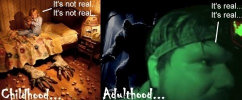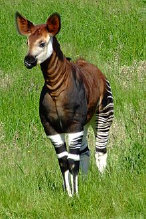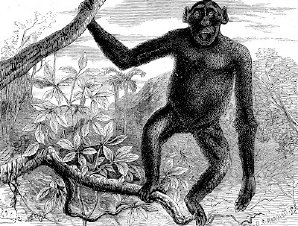
Contact

Home
The History of Yowie-Research
Yowie / Bigfoot
1993
Men, monkeys and (maybe) the missing link
By: Graeme O'Neill
The Age (Melbourne, Vic)
Date: May 19, 1993
Page Number: 15
A species of primate ignored for 135 years could shed new light on man's link to the apes, reports GRAEME O'NEILL.
PLESIOSAURS cavort in Loch Ness, Big Foot stomps through the Douglas fir forests of Oregon, the yeti leaves its enormous footprints in the snows of the Himalayas, people on the Australian mainland see thylacines and pumas. Mythical beasts abound, but never in close proximity to a focused camera.
But every now and again, some new or previously cryptic beast turns up to confound the sceptics or to delight scientists. The okapi, a short-necked, striped relative of the giraffe, walked in front of a white hunter's rifle in the Congo earlier this century, confirming what the pygmies in the area had known for thousands of years.
Fishermen on the Comoros Islands off the east coast of Africa had been catching coelacanths for centuries, when they had supposedly been extinct for 70 million years. When one finally bellied-up in front of a Western biologist in 1938, it caused almost as much surprise as if a Tyrannosaur had turned up in the Brazilian rainforest.
The aqua incognita of the world's oceans often disgorge new monsters like the plankton-feeding "Megamouth" shark found last decade off Hawaii, and several previously unknown small whales that live in open ocean to the west of South America.
Science has a duty to remain sceptical about claims made for mythical beasts, but occasionally gets it wrong. It was well into the 19th Century before the British scientific establishment accepted that Australia's platypus was not a hoax cobbled together by a taxidermist.
The greatest scepticism attaches to claims for man-like beasts like the yeti and Bigfoot, and Australia's home-grown hominoid, the yowie.
No substantial evidence exists for Bigfoot and the yeti, and hoaxes are common. But professional sceptics should read a scientific paper titled 'The Great Apes of Africa', written by Professor Roger Short of Monash University and published in the 'Journal of Reproduction and Fertility' in 1980.
Derek Denton drew my attention to Short's paper this year, while I was interviewing him about his new book on the brain and mind, 'The Pinnacle of Life'. Short points out that Western science also refused to believe in the existence of a second great ape in Africa, the gorilla, until the middle of last century. In Ancient Greece, Homer may have been alluding to the gorilla when he described "wild men" living on the west coast of Africa in 500BC.
The first scientific account of the gorilla appeared in a paper, 'Notice of the external characters and habits of Troglodytes gorilla, a new species of Orang from the Gaboon River', published in 1847.
Its author was an American missionary doctor named Savage, who had visited a fellow American missionary living on the Gaboon River in April that year. While there he was shown the large skull of an ape killed by local tribesmen, and recognised that it was probably a new species, distinct from the only other African great ape known at the time, the chimpanzee.
As recently as 1929, again to the great surprise of Western science, the number of great apes in Africa rose to three with the discovery of a new, slightly smaller species of chimpanzee, the bonobo or pygmy chimp, Pan paniscus - the closest relative of humans and most like us in its social organisation and behavior: it is intelligent, inventive and sexually promiscuous.
In 1993, the tally of human-like apes rests at four, including the Orang-utan, Pongo, from the rainforests of Borneo and Sarawak. With humans fast carving up what remains of the rainforest habitat of our hominoid relatives, the likelihood of finding any more would seem to be zero.
But that would be to ignore the kooloo-kamba.
In 'The Great Apes of Africa', Short describes how a French explorer called du Chaillu shot and killed one of these animals in the Ashwankolo Mountains near the headwaters of the Ovenga River in south-west Gabon in 1858. Du Chaillu visited England in 1861 with a collection of great-ape skulls, including skulls of the gorilla.
Nearly 15 years after Savage's paper, the British scientific establishment was still pooh-poohing the gorilla. Du Chaillu was accused of being a fraud.
Du Chaillu had another, very different skull in his collection - that of the animal he had shot in Gabon in 1858. He described his encounter with the animal thus: "This ape, whose singular cry distinguishes it at once from all its congeners in these wilds, is remarkable, as bearing a closer resemblance to man than any other ape yet known. It is very rare, and I was able to obtain but one specimen of it.
"The kooloo-kamba skull being placed in situ, the whole head preserves, unrestrained, its erect position."
Short observes: "One might be tempted to dismiss this account of a new species, or sub-species, of chimpanzee, were it not for the excellent drawings of the skull provided by du Chaillu, and the fact that they tally so closely with the actual skull, which is still preserved in the British Museum."
While visiting the US, Short showed a photograph of the skull to Donald Johansen, the famous paleontologist who discovered "Lucy", the 3.8million-year-old Australopithecus afarensis ancestor of humans from Ethiopia, and asked Johansen what he thought. Without pausing, Johanson said: "Oh, that's a new species.
Only one specimen of the kooloo-kamba exists; its status in the wild remains unknown. It has probably become extinct. Many features of the skull are intermediate between chimpanzees and humans. Short doubts that it is hybrid, the product of miscegenation between a human and a chimpanzee, although he says that there is probably no physical or genetic impediment to a productive union between them.
Humans have 46 chromosomes; chimpanzees have 48. Recent studies suggest that they have more than 98 per cent of their DNA in common, which means they are much more closely related than, say, a horse and a donkey, which hybridise to make mules. Mules are sterile; a human-chimp hybrid would probably be fertile.
What was or is the kooloo-kamba? Physically, it is an excellent candidate to be that mythical beast that obsessed Western science last century: after Charles Darwin suggested that humans and great apes were related by descent - the so-called missing link.
The skull in the British Museum is relatively young. A powerful DNA- analysis technique called the polymerase chain reaction is now available to amplify DNA samples from it, to allow its genes to be compared with those of humans and chimps. The results would be fascinating.

The History of Yowie Research




















